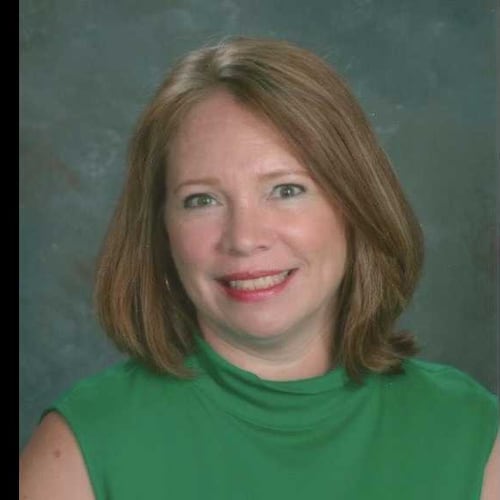Every day, Gwinnett County Public Schools’ website showcases a student and a staff member in the “Promise of Gwinnett” initiative. A photo and an inspirational quote highlight the county’s diversity and the school system’s emphasis on achievement.
A Latina girl named Esther said on Feb. 12: “I try to support others around me rather than see them as stepping stones to only support myself, regardless of religion, race, gender, background, or aspirations.” On another day, a boy named Jordan, who is black, said: “I’m going to help babies and people by being a doctor one day. I also want to help others through music.”
In this school system, there’s no typical student. One of the smartest kids in school may have dreadlocks, play on the football team or speak fluent Hindi or any of 100 languages. Most students, by far, are minorities, and a growing number are from immigrant families.
Gwinnett, the largest system in the state and 12th largest in the country, consistently ranks at the top of test scores and student success measures. That stands in contrast to the struggles of other metro minority districts.
How has Gwinnett done it?
Superintendent J. Alvin Wilbanks, who has held that job more than two decades, recently sat down with The Atlanta Journal-Constitution and cited three strong components: sustained leadership, goal-oriented innovation and unwavering focus on student success, especially for minorities and low-income students who are most likely to fall through the cracks.
Related story: Gwinnett outperforms state on SAT
Gwinnett County is a two-time winner of the $1 million Broad Prize, an annual nationwide award honoring large urban school districts with the strongest overall performance and improvement in student achievement while reducing achievement gaps among low-income students and students of color. That happened as the student population changed: More than half of the district’s teachers are white but today more than three-quarters of of its students are not.
Understanding student needs
State Superintendent Richard Woods said, “Leaders in Gwinnett have built a culture of seeking creative solutions,” designing curriculum and supports based on the needs of their community.
Credit: Christina Matacotta
Credit: Christina Matacotta
One factor that creates needs for Gwinnett and other school systems is poverty.
At last count, nearly half of Gwinnett’s 138 schools fell under Title I, the federal program for schools with a majority of low-income students.
For children who live in poverty, education can take a backseat to having enough to eat, living in a safe environment and just being able to get to school. And children of color are about three times as likely to live in a poor family as white children.
Annual analyses of performance with at-risk student groups showed more than two thirds Gwinnett County schools beat the odds. The Governor’s Office of Student Achievement compares schools’ success in teaching students who are affected by factors outside the school’s control such as race, ethnicity, disabilities, English fluency, economic disadvantage and transience.
Related story: Students find manufacturing jobs don't mean low pay
To help staff understand the issues students living in poverty face, Gwinnett set up professional development training through author and national education consultant Ruby Payne, based on Payne’s self-published book, “Emotional Poverty.”
But some of the most effective aid is addressing basic needs like having enough to eat.
By cutting down on food waste, many Gwinnett schools have helped some with food insecurity. Children are encouraged to put unopened packaged food from lunch on sharing tables for those who made need a little extra. Refrigerators keep perishables like milk and apples slices cold, and anyone can quietly select a snack or a something to nibble on at home.
And students come up with ways to help each other. Hispanic Organization Promoting Education is a student-initiated group whose goal is to increase the graduation rate among Hispanic high school students through leadership, education and community service. Monthly meetings include activities to help students become leaders in the community.
Sylvia Goalen has seen firsthand how effective self-help has been for her son Michael, a Gwinnett graduate who was a member of that group. Now a senior at Georgia State, he’s the first generation of his family born in the United States. Sylvia, born in Guatemala, came to this country as a child and worked hard to get a college education and make a better life for her children.
“It was important for him to see how people like him were succeeding through education,” she said. “Those positive images break the cycle of low wage-earners and put families on a path to empowerment and being productive members of the community.”
Events like the Gwinnett County Regional Science, Engineering + Innovation Fair illustrate the district’s success with efforts to include all students.
On a crisp February morning about a thousand students filed in the Infinite Energy Center around 7 a.m. to start setting up science projects. Nearly 500 projects had placed first in their grade at the local school level, and the best of these best student researchers were judged by Georgia professionals and scientists for scientific quality, accuracy, creativity and experimental or engineering design.
Projects involved finding solutions for real-world problems such as getting rid of household fats, oils and grease; reducing phosphorous levels in Lake Lanier; protecting bees and other Georgia pollinators, and maintaining healthy soil in the state.
Related story: Teachers gain computer science savvy; kids apply science to problems
But it wasn’t the wealthiest section of the county that had the most winners.
Shiloh Middle School, with 95% minority students, 32% economically disadvantaged and 13% whose native language isn’t English, had the most students move on to the state competition.
“That’s classic of what we strive for,” said Jessica Holden, Gwinnett science director for grades 6-12. “We motivate and instruct every student to find their passion.”
Innovation
One of the most effective ways to boost minority student achievement, according to the nonprofit Annie E. Casey Foundation, is early education for all students. Gwinnett’s response to that need and others illustrates the willingness to innovate that Wilbanks noted.
When Gwinnett realized, based on data it began gathering in 2015, that less than half of its children entered kindergarten prepared to be students, it devised the Play 2 Learn program. It teaches parents to be the first teachers for youngsters up to five years old. A 90-minute, weekly class sets up different activities for families and a monthly calendar allows caregivers to continue the program at home. So far anecdotal evidence shows improved readiness.
Related story: Gwinnett schools focus on preparing tots for kindergarten
Gwinnett also partnered with Gwinnett Reading Exchange & Art Transforms in a campaign designed to inspire love of reading and provide children’s books in areas where books are scarce, and encourage appreciation for public art.
Students at Maxwell High School of Technology built 200 little libraries, stands filled with books, that will be placed throughout the county, mainly in high-poverty areas. Students and others decorated the mini libraries, and student stewards are assigned to make sure they are stocked. “Putting books in students’ hands is a win by any measure,” said Kim Holland, Gwinnett schools director of early learning and school readiness. “These libraries are putting little ones on the path to learning.”
Related story: Gwinnett little libraries project aims for big impact on early learning
The district used the libraries to further programs such as the summer Bookmobile and other book giveaways that had already showed a significant impact on reading.
In her 15 years in Gwinnett County, the emphasis on reading stood out for Nonka Kouzmanova. Both of the Bulgarian immigrant’s children — an eighth grade daughter and a fourth grade son — are in gifted and accelerated classes.
“If you don’t have good reading comprehension, nothing else will make sense,” she said.
Kouzmanova is on the state superintendent’s parent advisory council and she keeps a close eye on education matters.
“The teachers work with every student in a way that works for them,” she said. “I’ve seen it work in Title I schools to the wealthiest in the county. No child is treated differently because of their background.”
The district’s renewed emphasis on career-readiness for high school students prompted the Georgia Association for Career and Technical Education to recognize Wilbanks in July as the first recipient of its lifetime achievement award. Gwinnett has high school programs geared toward fields including medical, construction trades, arts and entertainment to begin prepping students for college or careers.
It’s the emphasis on letting parents and students choose what success looks like that sold Meshana Spivey on Gwinnett.
The family moved from DeKalb County to Snellville when her oldest child was near middle school age, and she hasn’t regretted the decision. Spivey’s daughter is in 10th grade at South Gwinnett High. “She wants to be a pediatrician and she’s learning things in high school that are preparing her for that career,” said Spivey.
Related story: New school focuses on health careers
Spivey was one of six people awarded by the Department of Education and the Georgia Parent Teacher Association for her involvement in Magill’s PTA as a volunteer and the school’s PTA president. She said she’s seen firsthand how teachers and administrators have the students’ best interests at heart.
Training, keeping school leaders
“From my perspective, much of Gwinnett County Public Schools’ success can be attributed to their focus on leadership. They have a skilled, steady leader in their superintendent, Alvin Wilbanks, and he has prioritized building a pipeline of principals and district-level leaders who are prepared and know the district’s instructional priorities and practices,” said Woods, Georgia’s superintendent.
“At the state level, we’re always looking for successful practices that can be scaled up,” and are now using Gwinnett’s principal-training program as a model, he said. The goal is to get more people qualified to head underperforming schools by growing leaders from within school systems.
Gwinnett has been so successful that almost nine out of 10 of its schools are led by graduates of its program, the Quality-Plus Leader Academy. The year-long instructional program led by the superintendent and other district leaders includes a 90-day residency in a school to put participants — teachers who aspire to being principals — in real-life scenarios. They might deal with irate parents, for example, or discipline misbehaving students.
The staying power of the leader at the top matters for schools, too.
The average time in the job for big-city superintendents is about 5.5 years. Among current superintendents, the average leader of a large, urban district has been in that job for three to four years. Wilbanks has led Gwinnett schools 24 years.
“For a large school district it takes at least three years to get any program off the ground,” Wilbanks said “You have to make adjustments in the first year or two and get everyone familiar with the particulars.”
If the highest office isn’t there to see the program to success, it likely won’t be a success, he added. “The next person in that position will have his or her own ideas and ways of doing things,” he said. “It’s not that there is anything wrong with their ideas or those of the predecessor, but if you don’t give something a fighting chance, it’s basically set up to fail.”
Education researchers have found steady leadership is a greater challenge in districts with the highest proportions of low-income students and students of color. In such metro Atlanta districts, superintendents haven’t lasted long.
Fulton County, the state’s fourth largest school district, has a new superintendent, Mike Looney. He’s Fulton’s fourth, not including interims, since spring 2008. DeKalb and Atlanta decided not to extend superintendents’ contracts and are seeking new leaders. DeKalb’s Stephen Green and Atlanta’s Meria Carstarphen held those positions for four years and five years respectively.
Dan Domenech, executive director of AASA, The School Superintendents Association, said one of the most important factors for stable school district leadership is the relationship between the superintendent and the school board.
Wilbanks has been with Gwinnett since 1996 — a year before Mary Kay Murphy, the current member with the second-longest time in her seat, took office and 23 years after board member Louise Radloff, the longest serving board member, was elected to her seat on the board.
Related story: Gwinnett gives school district leader two more years
“I remember when we hired him,” Radloff quips often. “There aren’t many people around who can say that!”
Woods said, “From what we have observed in our work with hundreds of chief executives and management professionals in public school systems over the past 15 years, we believe that longevity matters. At the same time, effective superintendents make the most of whatever time they have.”
Said Wilbanks, “Our job is to expand opportunities for our students, not limit them. When every student succeeds we’ve done our job well.”
Gwinnett County Public Schools student demographics
Students: 180,324
Countries represented: 181
Languages spoken: 100
Student body
American Indian/Alaska Native: 0.2%
Asian/Pacific Islander: 10%
Black: 33%
Hispanic: 32%
Multiracial: 4%
White: 21%
Economically disadvantaged: 56%
English learners: 23%
Students with disabilities: 14%
Gwinnett County’s overall performance is higher than 93% of Georgia school districts, according to the Governor’s Office of Student Achievement. In 2019:
- Its elementary students' academic growth was higher than 93% of districts.
- Its middle school students' academic growth was higher than 78% of districts.
- Its high school students' academic growth was higher than 59% of districts.
- 79% of its 3rd grade students were reading at or above the grade level target compared to 73% statewide.
- 80.9% of its 8th grade students were reading at or above the grade level target compared to 74% statewide.
- Its four-year graduation rate was 81.7%, which was higher than 15% of districts and just about level with the state average.
- Graduates were offered more than $203.6 million in academic, athletic, and military scholarships
- 57.4% of graduates were college- and career-ready which was even with the state average.
About the Author
Keep Reading
The Latest
Featured





